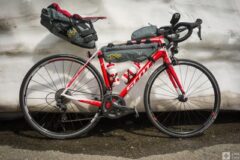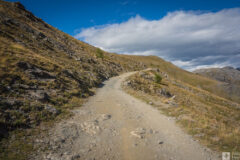Instead of doing multi-day training rides to prepare physically for bikepacking races, you should do them to test strategies and equipment and learn or perfect important skills.

Page Contents:
Physical Training
It’s natural to assume that to ride the distances that are needed in ultra-distance bike races, you must do many, very long rides to get your body physically prepared. However, most coaches and trainers of ultracyclists believe that rides longer than about 4-6 hours do not increase your physical capabilities. In fact, very long rides normally take longer for your body to recover from, which can prevent you from doing other productive training rides for a few days, so doing extra-long rides may even reduce the effectiveness of your physical training. This is because your body gains muscle and strength and becomes efficient at supplying your muscles with energy by riding, but rides of longer than about 4-6 hours don’t yield any additional gains in this respect.
Even so, full-day and multi-day training rides are an essential part of your preparation for ultra-distance events because those rides should reveal any physical problems or pains that develop and help you to obtain the skills and experience needed to ride an ultra-distance race, especially one that is self-supported and so requires extra skills to be mastered. If you experience specific pains during training, hopefully you can make changes to your Riding Position or equipment to avoid them occurring during the race.
Mental Training
During long-distance training rides, you should experiment with various Nutrition Strategies and Sleeping Strategies to find out what does and doesn’t work for you. You need to learn how to listen to your body, when to eat, when to take it easy, when pushing on to one more town before stopping is a bad idea, etc. You will have patches when your energy levels are low or you are mentally down or fatigued – learn what you can by fighting through them and what is the best way to avoid such phases (see the Mood, Motivation & Emotions page).
Equipment Testing
Longer training rides, particularly overnight trips, are times when you should use as much of your race equipment as possible, so it’s important that you obtain it early. Find out what things you needed but didn’t take and what you took but didn’t need. Become a master of every aspect of your Navigation Device, Headlight, etc. Discover the battery life of your electronic devices and test out how you plan to charge them (see the USB Chargers page). Don’t be put off by a poor weather forecast, use the opportunity to decide whether your wet & cold weather Clothing is going to be sufficient.
Skill Development
On longer rides, pay attention to how much time you spend off the bike and how much time on the bike. Spending at least 80% to 90% of the elapsed time actually in the saddle is a good Moving Percentage. Being skilled at not wasting time when off the bike is almost as important as how fast you’re able to ride when on the bike, and is something that you can improve with practice (see the Time Management & Measuring Time Efficiency page).
Long rides are also opportunities to practice Route Planning, Schedule & Goals and Time Management, especially if you increase the similarity of your training rides to race conditions by visiting regions that you don’t know.
Recovery
Extra-long training rides will obviously make you feel weaker and more tired for a few days. There is evidence that instead of resting completely during this time, doing some short, low intensity rides during this period can aid recovery by promoting blood circulation and reducing inflammation.
Conclusion
I therefore recommend doing do some multi-day training rides during the months leading up to a big event. On such rides you should aim to be on the bike for 10+ hours per a day. Remember that the rides are not so much about physical training but are more about learning how to cope mentally with such rides, learning what strategies do and don’t work for you, testing the equipment you plan to use during the event, etc. Keep an eye on your rate of progress and analyze it afterwards to help you to create a realistic schedule for your big event. There is no need to make the ride excessively physically demanding or to completely destroy yourself before coming home, that is not the goal of these rides – you can save that for shorter efforts during regular training.
Last significant page update: February, 2018
This page is in the Physical Training section. The next page in this section is:

